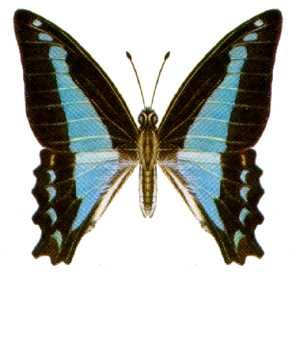Common Bluebottle (Graphium sarpedon) - Wiki Graphium sarpedon
From Wikipedia, the free encyclopedia
[Photo] Graphium sarpedon choredon. Picture of Graphium sarpedon choredon, taken from the entry page for the butterfly at the entomology branch of CSIRO, Australia's national science agency. The image appearing on the page is marked copyright free, having been investigated per the Australian Copyright Act.
Graphium sarpedon, the common bluebottle, is a species of swallowtail butterfly found in South and Southeast Asia, as well as parts of Australia. There are approximately 15 subspecies with differing geographical distributions.
Description
Upperside opaque black. Fore and hind wings crossed from above the tornal area on tho hind to near the apex of the fore wing by a semi-hyaline broad pale blue medial band which is broadest in the middle, more or less greenish and macular anteriorly; the portion of the band that crosses interspaces 6, 7 and 8 on the hind wing white; beyond the band on the hind wing there is a sub-terminal line of blue slender lunules. Underside similar, ground-colour dark brown. Hind wing: a short comparatively broad sub-basal band from costa to sub-costal vein, and the postdiscal area between the medial blue band and the sub-terminal lunules velvety black traversed by the pale veins and transversely, except in interspaces 6 and 7, by narrow crimson lines; lastly, a crimson spot near the tornal angle with an admarginal yellowish-white spot below it. Antenna, head, thorax and abdomen brown, the head and thorax suffused with greenish grey; beneath: the palpi, thorax and abdomen touched with dingy white, the abdomen with two whitish lateral lines.
Male has abdominal fold within grey, furnished with a tuft of long, somewhat stiff white hairs.
Race teredon, Felder. (South India and Sri Lanka) is distinguishable in both sexes by the narrower medial band that crosses both fore and hind wing. Colour brighter, the contrast between the green of the upper and the blue of the lower portion of the medial band more vivid. Hind wing more produced posteriorly at apex of vein 3, where it forms an elongate tooth or short tail.
Variously reported with wingspans between 55 and 75 mm, the common bluebottle has black upper wings and brown lower wings. Both fore and hind wings are marked by a central spot in the form of a blue or blue-green triangle, with apex pointing toward the body.
The common bluebottle is known for quick flight and rapid reactions. It is difficult to catch.
Habitat
Graphium sarpedon is primarily an inhabitant of moist, low-level rain forests (below 1600 m/5000 feet). In these elevations it is usually seen flying just above the tree canopy. The larvae of the common bluebottle feed on trees of the laurel family, which includes the cinnamon tree, and have expanded their range to include cinnamon tree plantations. In eastern Australia, they have adapted to a drier subtropical environment, and are commonly seen in suburban gardens in Queensland and New South Wales.
The males are known for their habit of feeding by the edges of puddles, often at the roadside. Occasionally, as many as eight will be seen at the same puddle. They have also been known to be attracted to animal droppings, carcasses and rotting insects.
Distribution
The common bluebottle is distributed throughout south and southeast Asia. Subspecies appear in India and Sri Lanka (G. s. sarpedon and teredon), China and Taiwan (G. s. semifasciatus and connectens), Japan (G. s. nipponum), Indonesia and the Solomon Islands, New Guinea (G. s. messogis), and Australia (G. s. choredon). In India it occurs in Southern India in the Western Ghats and in the Himalayas from Kashmir in the west to Myanmar in the east.
Diet
The adult common bluebottle feeds on a variety of flowering herbs. The larvae feed primarily on the leaves of trees in the families Lauraceae, Myrtaceae, Sapotaceae, and Rutaceae. In particular, G.s. sarpedon and G.s. teredon often feed on leaves of the cinnamon bark tree, Cinnamomum zeylanica, or of the Indian laurel, Litsea sebifera.
The list of larval food plants also include Alseodaphne semecarpifolia, Cinnamomum camphora, Cinnamomum macrocarpum, Cinnamomum malabatrum, Litsea chinensis, Polyalthia longifolia, Miliusa tomentosa, Persea macrantha and Michelia doltospa.
The larvae of G.s. choredon, native to Australia, feed on many native Australian species of genera Cryptocarya and Litsea; and virtually all subspecies feed on leaves of the camphor tree, Cinnamomum camphori, which is native to China but has been naturalized throughout southeast Asia.
Reproduction and development
Egg
The egg is yellowish, laid singly on the leaves of host plants.
Larva
When young, is black or dark green, with numerous spines; when full grown, it is green with a short spines on each thoracic segment and anal segment. There is a transverse yellow band on the 4th segment and a lateral band on the body. The caterpillar usually lies on the centre of a leaf on an upper surface. It is very sluggish and pupates near its feeding spot. " Smooth, thickened from the second to the 5th segment and thence decreasing to the end; with two short subdorsal fleshy spines on the 4th segment, between which is a transverse pale yellow line, two shorter spines also on the 2nd and 3rd and two on the anal segment; colour green, with a longitudinal posterior lateral and lower pale yellowish line." (Frederic Moore quoted in Bingham, 1907)
Pupa
The pupa is green with a slender and pointed thoracic projection, yellowish wingcases and lateral bands. "Conical, truncated in front; thorax produced into a lengthened obtusely-pointed frontal process." (Frederic Moore quoted in Bingham, 1907)
http://en.wikipedia.org/wiki/Graphium_sarpedon
| The text in this page is based on the copyrighted Wikipedia article shown in above URL. It is used under the GNU Free Documentation License. You may redistribute it, verbatim or modified, providing that you comply with the terms of the GFDL. |
